Biosciences for Nursing Workbook: Body, Cell, and Homeostasis - Year 1
VerifiedAdded on 2023/06/04
|19
|3889
|51
Homework Assignment
AI Summary
This assignment is a comprehensive Year 1 Biosciences workbook designed for nursing students. It covers fundamental concepts including body compartments, cell structure, and homeostasis. The workbook includes definitions, organ location identification within body cavities, and detailed explanations of cellular components such as the cytosol, cell types, and organelles. It also explores key cellular processes like osmosis and active transport, providing examples and descriptions of their mechanisms. The document features labeled diagrams and fill-in-the-blank exercises to reinforce understanding. The workbook aims to enhance students' knowledge and provide a self-assessment tool to prepare for quizzes and further study. It encourages active learning through engagement with lecture notes and textbooks to extend knowledge beyond the provided material.
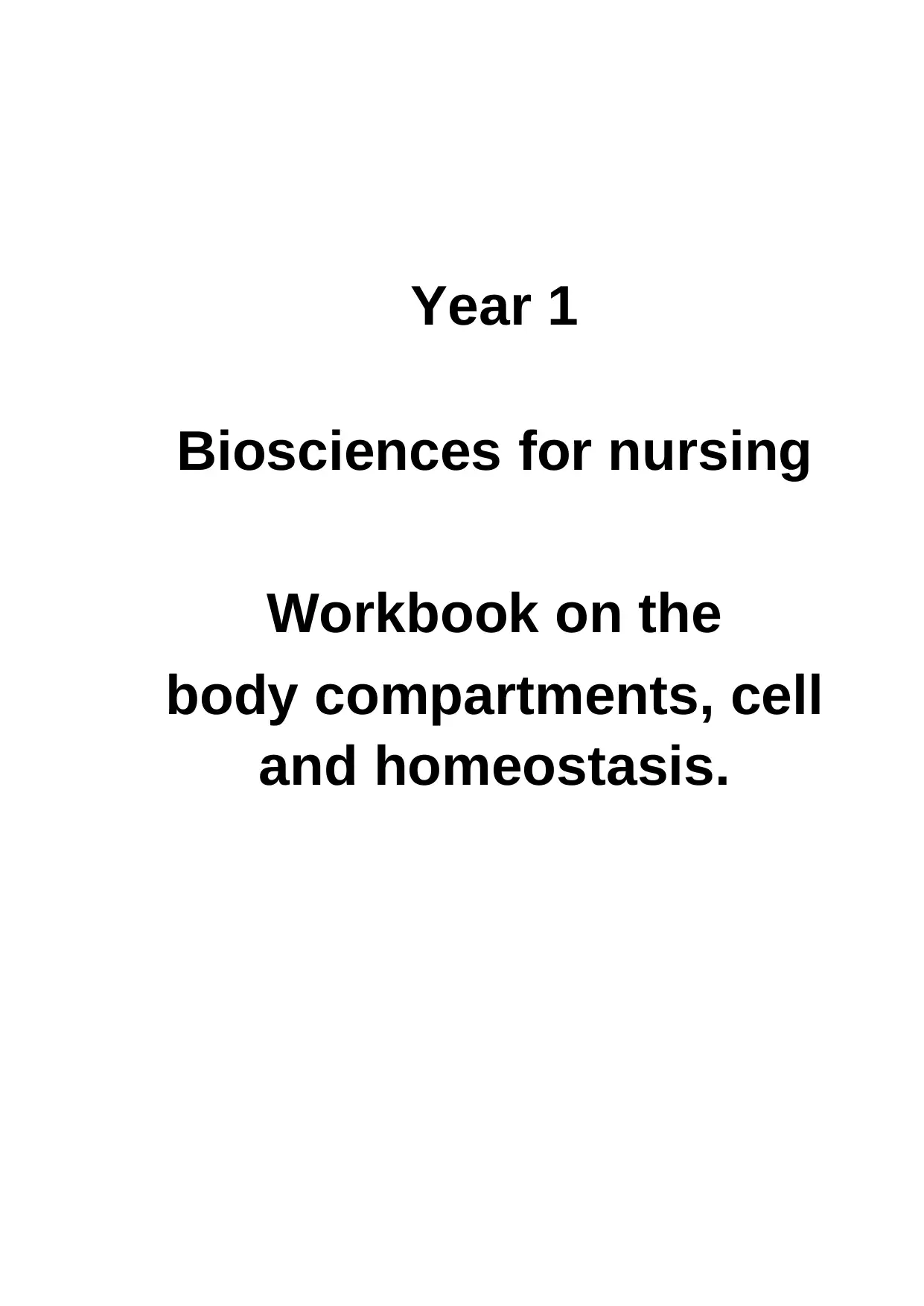
Year 1
Biosciences for nursing
Workbook on the
body compartments, cell
and homeostasis.
Biosciences for nursing
Workbook on the
body compartments, cell
and homeostasis.
Paraphrase This Document
Need a fresh take? Get an instant paraphrase of this document with our AI Paraphraser
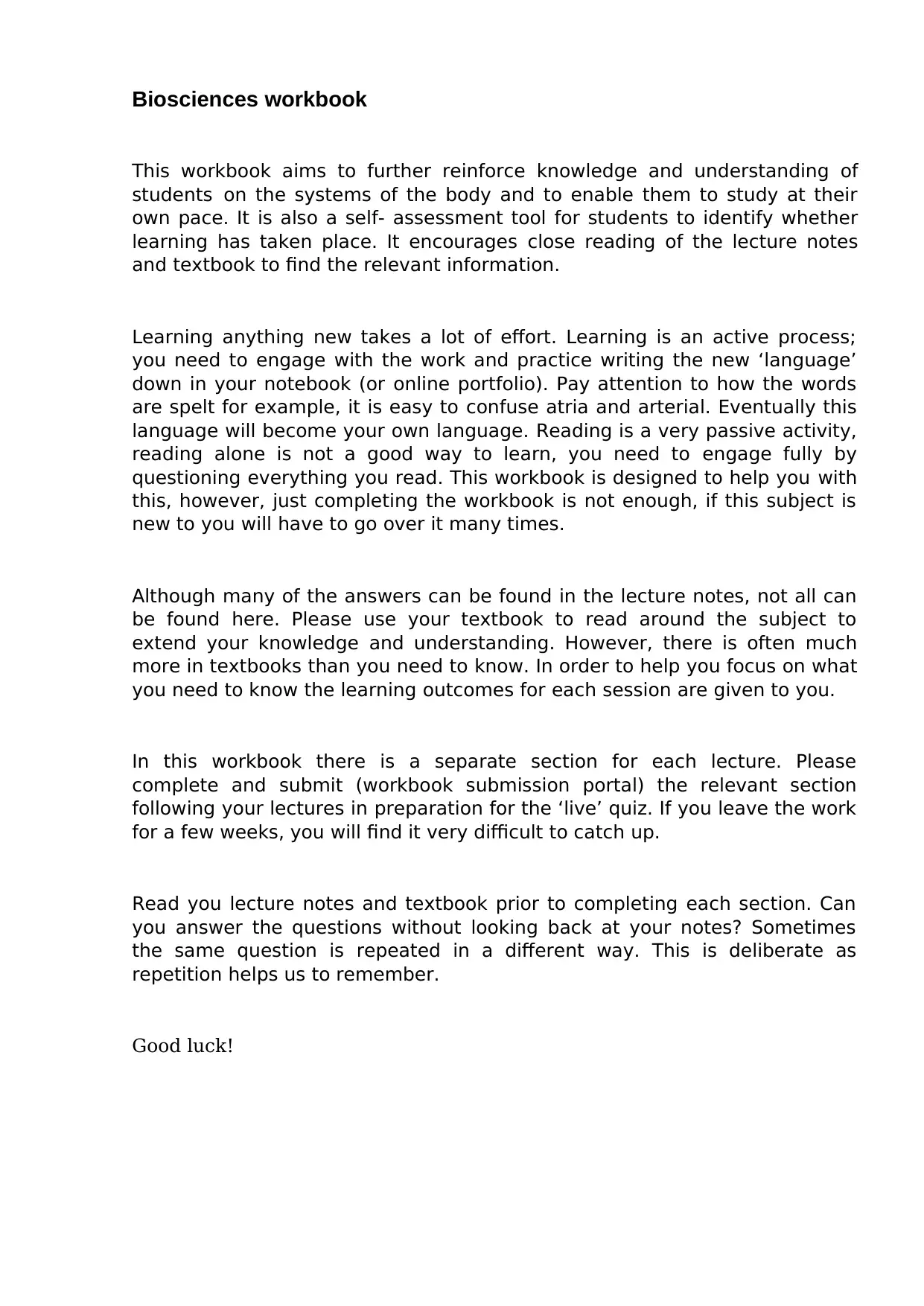
Biosciences workbook
This workbook aims to further reinforce knowledge and understanding of
students on the systems of the body and to enable them to study at their
own pace. It is also a self- assessment tool for students to identify whether
learning has taken place. It encourages close reading of the lecture notes
and textbook to find the relevant information.
Learning anything new takes a lot of effort. Learning is an active process;
you need to engage with the work and practice writing the new ‘language’
down in your notebook (or online portfolio). Pay attention to how the words
are spelt for example, it is easy to confuse atria and arterial. Eventually this
language will become your own language. Reading is a very passive activity,
reading alone is not a good way to learn, you need to engage fully by
questioning everything you read. This workbook is designed to help you with
this, however, just completing the workbook is not enough, if this subject is
new to you will have to go over it many times.
Although many of the answers can be found in the lecture notes, not all can
be found here. Please use your textbook to read around the subject to
extend your knowledge and understanding. However, there is often much
more in textbooks than you need to know. In order to help you focus on what
you need to know the learning outcomes for each session are given to you.
In this workbook there is a separate section for each lecture. Please
complete and submit (workbook submission portal) the relevant section
following your lectures in preparation for the ‘live’ quiz. If you leave the work
for a few weeks, you will find it very difficult to catch up.
Read you lecture notes and textbook prior to completing each section. Can
you answer the questions without looking back at your notes? Sometimes
the same question is repeated in a different way. This is deliberate as
repetition helps us to remember.
Good luck!
This workbook aims to further reinforce knowledge and understanding of
students on the systems of the body and to enable them to study at their
own pace. It is also a self- assessment tool for students to identify whether
learning has taken place. It encourages close reading of the lecture notes
and textbook to find the relevant information.
Learning anything new takes a lot of effort. Learning is an active process;
you need to engage with the work and practice writing the new ‘language’
down in your notebook (or online portfolio). Pay attention to how the words
are spelt for example, it is easy to confuse atria and arterial. Eventually this
language will become your own language. Reading is a very passive activity,
reading alone is not a good way to learn, you need to engage fully by
questioning everything you read. This workbook is designed to help you with
this, however, just completing the workbook is not enough, if this subject is
new to you will have to go over it many times.
Although many of the answers can be found in the lecture notes, not all can
be found here. Please use your textbook to read around the subject to
extend your knowledge and understanding. However, there is often much
more in textbooks than you need to know. In order to help you focus on what
you need to know the learning outcomes for each session are given to you.
In this workbook there is a separate section for each lecture. Please
complete and submit (workbook submission portal) the relevant section
following your lectures in preparation for the ‘live’ quiz. If you leave the work
for a few weeks, you will find it very difficult to catch up.
Read you lecture notes and textbook prior to completing each section. Can
you answer the questions without looking back at your notes? Sometimes
the same question is repeated in a different way. This is deliberate as
repetition helps us to remember.
Good luck!
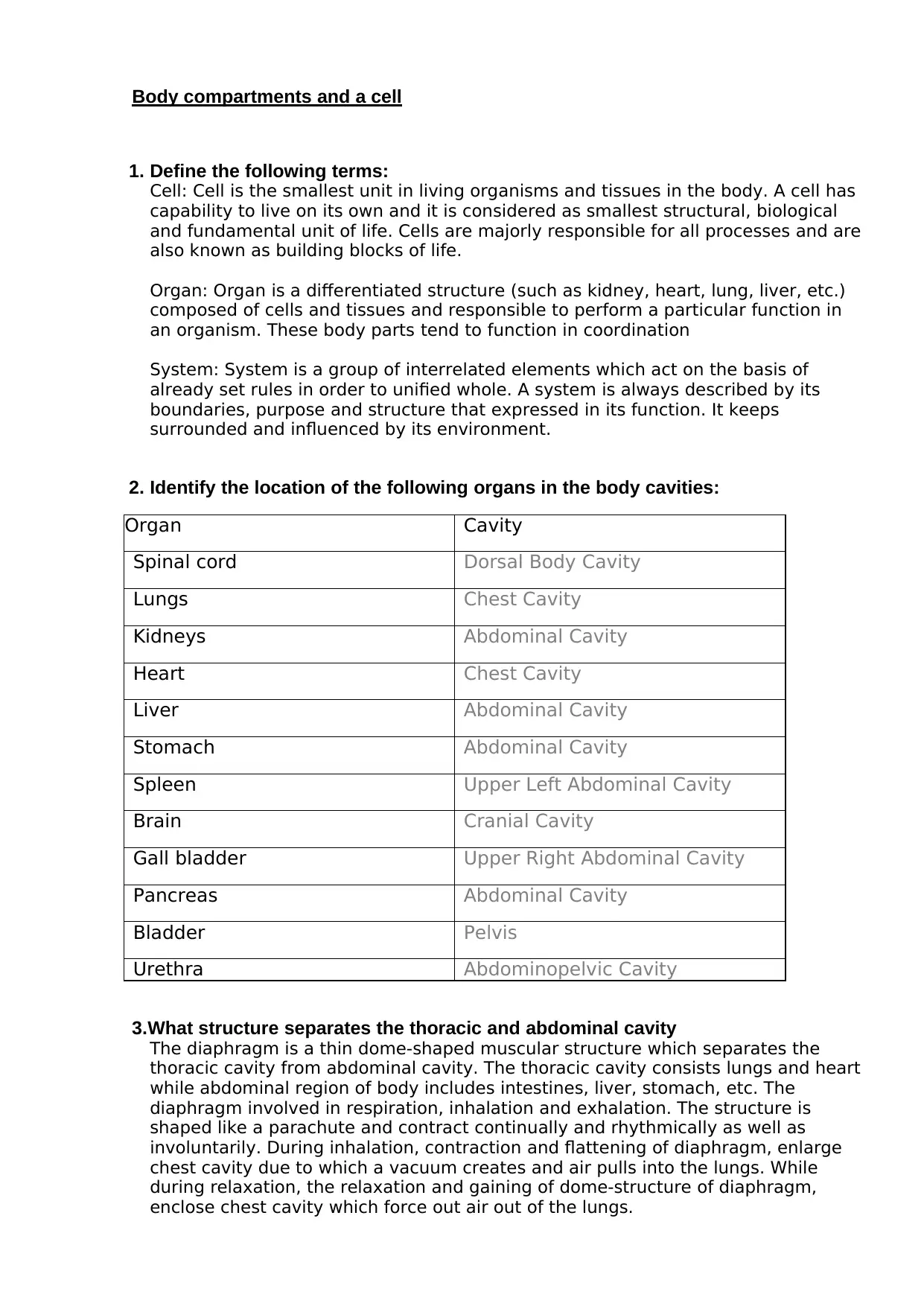
Body compartments and a cell
1. Define the following terms:
Cell: Cell is the smallest unit in living organisms and tissues in the body. A cell has
capability to live on its own and it is considered as smallest structural, biological
and fundamental unit of life. Cells are majorly responsible for all processes and are
also known as building blocks of life.
Organ: Organ is a differentiated structure (such as kidney, heart, lung, liver, etc.)
composed of cells and tissues and responsible to perform a particular function in
an organism. These body parts tend to function in coordination
System: System is a group of interrelated elements which act on the basis of
already set rules in order to unified whole. A system is always described by its
boundaries, purpose and structure that expressed in its function. It keeps
surrounded and influenced by its environment.
2. Identify the location of the following organs in the body cavities:
Organ Cavity
Spinal cord Dorsal Body Cavity
Lungs Chest Cavity
Kidneys Abdominal Cavity
Heart Chest Cavity
Liver Abdominal Cavity
Stomach Abdominal Cavity
Spleen Upper Left Abdominal Cavity
Brain Cranial Cavity
Gall bladder Upper Right Abdominal Cavity
Pancreas Abdominal Cavity
Bladder Pelvis
Urethra Abdominopelvic Cavity
3.What structure separates the thoracic and abdominal cavity
The diaphragm is a thin dome-shaped muscular structure which separates the
thoracic cavity from abdominal cavity. The thoracic cavity consists lungs and heart
while abdominal region of body includes intestines, liver, stomach, etc. The
diaphragm involved in respiration, inhalation and exhalation. The structure is
shaped like a parachute and contract continually and rhythmically as well as
involuntarily. During inhalation, contraction and flattening of diaphragm, enlarge
chest cavity due to which a vacuum creates and air pulls into the lungs. While
during relaxation, the relaxation and gaining of dome-structure of diaphragm,
enclose chest cavity which force out air out of the lungs.
1. Define the following terms:
Cell: Cell is the smallest unit in living organisms and tissues in the body. A cell has
capability to live on its own and it is considered as smallest structural, biological
and fundamental unit of life. Cells are majorly responsible for all processes and are
also known as building blocks of life.
Organ: Organ is a differentiated structure (such as kidney, heart, lung, liver, etc.)
composed of cells and tissues and responsible to perform a particular function in
an organism. These body parts tend to function in coordination
System: System is a group of interrelated elements which act on the basis of
already set rules in order to unified whole. A system is always described by its
boundaries, purpose and structure that expressed in its function. It keeps
surrounded and influenced by its environment.
2. Identify the location of the following organs in the body cavities:
Organ Cavity
Spinal cord Dorsal Body Cavity
Lungs Chest Cavity
Kidneys Abdominal Cavity
Heart Chest Cavity
Liver Abdominal Cavity
Stomach Abdominal Cavity
Spleen Upper Left Abdominal Cavity
Brain Cranial Cavity
Gall bladder Upper Right Abdominal Cavity
Pancreas Abdominal Cavity
Bladder Pelvis
Urethra Abdominopelvic Cavity
3.What structure separates the thoracic and abdominal cavity
The diaphragm is a thin dome-shaped muscular structure which separates the
thoracic cavity from abdominal cavity. The thoracic cavity consists lungs and heart
while abdominal region of body includes intestines, liver, stomach, etc. The
diaphragm involved in respiration, inhalation and exhalation. The structure is
shaped like a parachute and contract continually and rhythmically as well as
involuntarily. During inhalation, contraction and flattening of diaphragm, enlarge
chest cavity due to which a vacuum creates and air pulls into the lungs. While
during relaxation, the relaxation and gaining of dome-structure of diaphragm,
enclose chest cavity which force out air out of the lungs.
⊘ This is a preview!⊘
Do you want full access?
Subscribe today to unlock all pages.

Trusted by 1+ million students worldwide

3 Biosciences for nursing (Adult
Nursing)
Nursing)
Paraphrase This Document
Need a fresh take? Get an instant paraphrase of this document with our AI Paraphraser
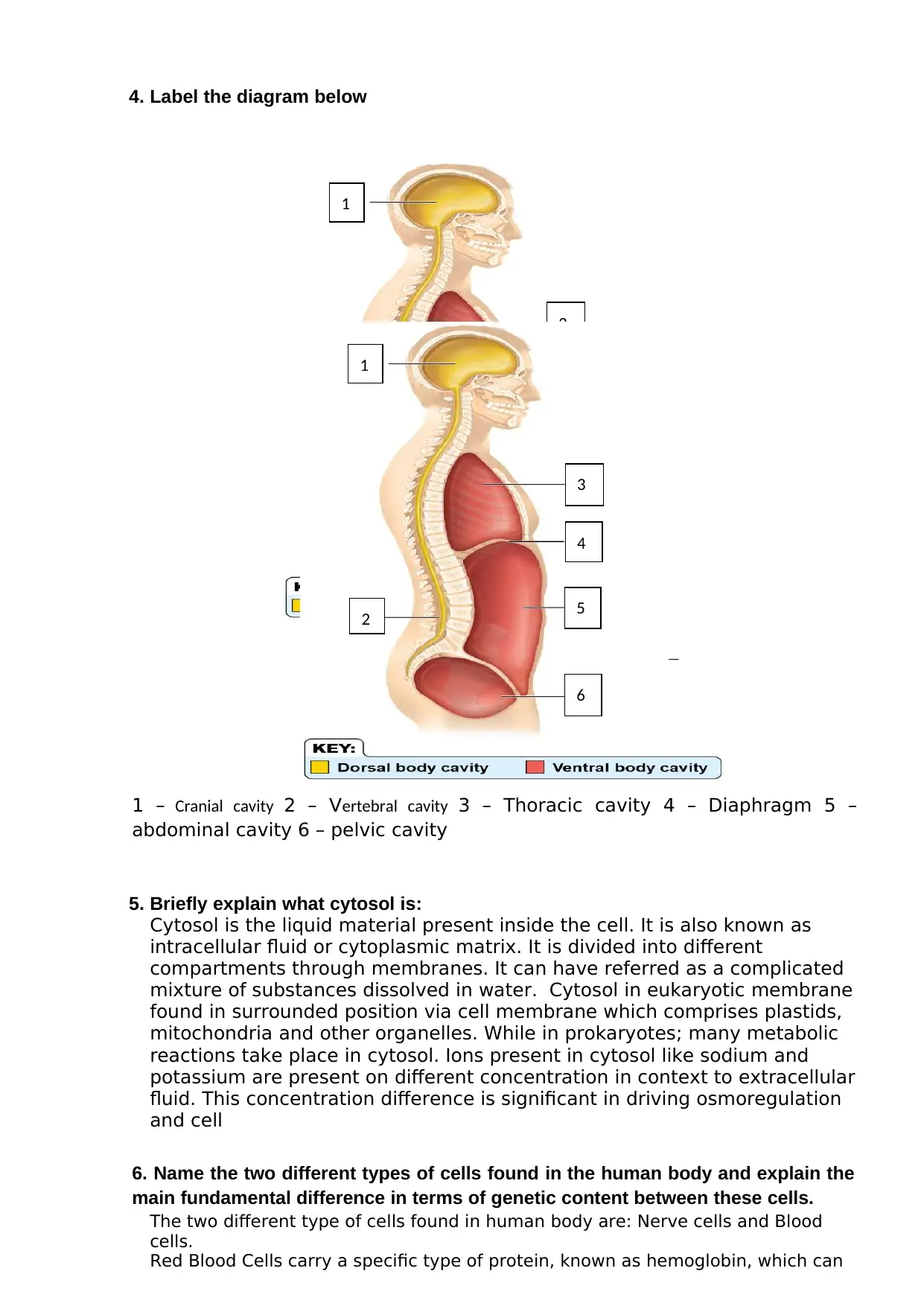
4. Label the diagram below
1 – Cranial cavity 2 – Vertebral cavity 3 – Thoracic cavity 4 – Diaphragm 5 –
abdominal cavity 6 – pelvic cavity
5. Briefly explain what cytosol is:
Cytosol is the liquid material present inside the cell. It is also known as
intracellular fluid or cytoplasmic matrix. It is divided into different
compartments through membranes. It can have referred as a complicated
mixture of substances dissolved in water. Cytosol in eukaryotic membrane
found in surrounded position via cell membrane which comprises plastids,
mitochondria and other organelles. While in prokaryotes; many metabolic
reactions take place in cytosol. Ions present in cytosol like sodium and
potassium are present on different concentration in context to extracellular
fluid. This concentration difference is significant in driving osmoregulation
and cell
6. Name the two different types of cells found in the human body and explain the
main fundamental difference in terms of genetic content between these cells.
The two different type of cells found in human body are: Nerve cells and Blood
cells.
Red Blood Cells carry a specific type of protein, known as hemoglobin, which can
1
3
4
2 5
6
1
3
4
2 5
6
1 – Cranial cavity 2 – Vertebral cavity 3 – Thoracic cavity 4 – Diaphragm 5 –
abdominal cavity 6 – pelvic cavity
5. Briefly explain what cytosol is:
Cytosol is the liquid material present inside the cell. It is also known as
intracellular fluid or cytoplasmic matrix. It is divided into different
compartments through membranes. It can have referred as a complicated
mixture of substances dissolved in water. Cytosol in eukaryotic membrane
found in surrounded position via cell membrane which comprises plastids,
mitochondria and other organelles. While in prokaryotes; many metabolic
reactions take place in cytosol. Ions present in cytosol like sodium and
potassium are present on different concentration in context to extracellular
fluid. This concentration difference is significant in driving osmoregulation
and cell
6. Name the two different types of cells found in the human body and explain the
main fundamental difference in terms of genetic content between these cells.
The two different type of cells found in human body are: Nerve cells and Blood
cells.
Red Blood Cells carry a specific type of protein, known as hemoglobin, which can
1
3
4
2 5
6
1
3
4
2 5
6

bind oxygen molecules while nerve cells lack of this protein as it does not need to
bind oxygen but protein present in nerve cells are found to be helpful in
transmitting signal from one cell to another.
.
bind oxygen but protein present in nerve cells are found to be helpful in
transmitting signal from one cell to another.
.
⊘ This is a preview!⊘
Do you want full access?
Subscribe today to unlock all pages.

Trusted by 1+ million students worldwide
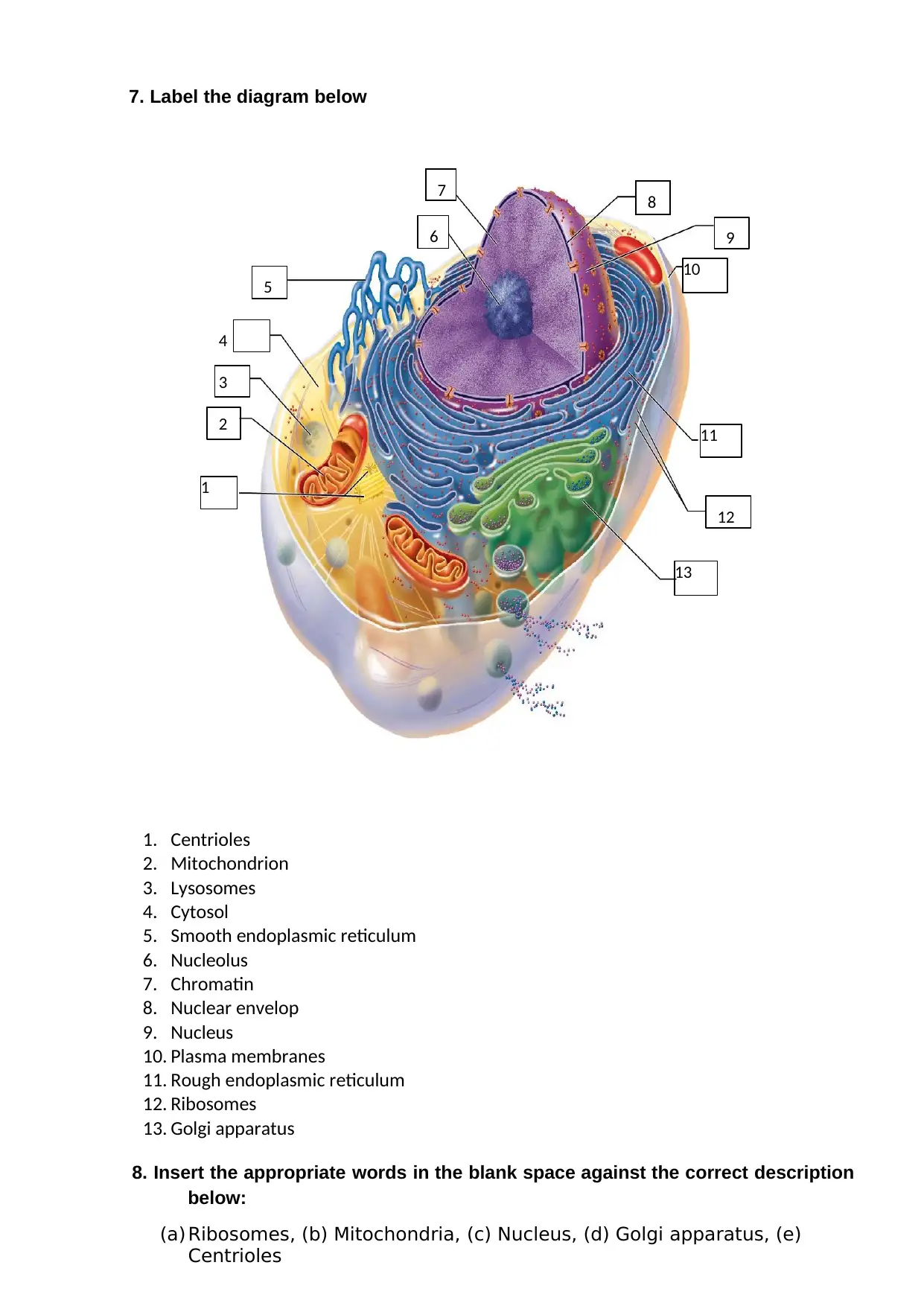
7. Label the diagram below
1. Centrioles
2. Mitochondrion
3. Lysosomes
4. Cytosol
5. Smooth endoplasmic reticulum
6. Nucleolus
7. Chromatin
8. Nuclear envelop
9. Nucleus
10. Plasma membranes
11. Rough endoplasmic reticulum
12. Ribosomes
13. Golgi apparatus
8. Insert the appropriate words in the blank space against the correct description
below:
(a) Ribosomes, (b) Mitochondria, (c) Nucleus, (d) Golgi apparatus, (e)
Centrioles
7 8
6 9
5
4
3
2
12
13
1
11
10
1. Centrioles
2. Mitochondrion
3. Lysosomes
4. Cytosol
5. Smooth endoplasmic reticulum
6. Nucleolus
7. Chromatin
8. Nuclear envelop
9. Nucleus
10. Plasma membranes
11. Rough endoplasmic reticulum
12. Ribosomes
13. Golgi apparatus
8. Insert the appropriate words in the blank space against the correct description
below:
(a) Ribosomes, (b) Mitochondria, (c) Nucleus, (d) Golgi apparatus, (e)
Centrioles
7 8
6 9
5
4
3
2
12
13
1
11
10
Paraphrase This Document
Need a fresh take? Get an instant paraphrase of this document with our AI Paraphraser

1. Mitochondria – production of energy in the form of ATP
2. Centrioles - are found near the nucleus and are involved in cell division
2. Centrioles - are found near the nucleus and are involved in cell division
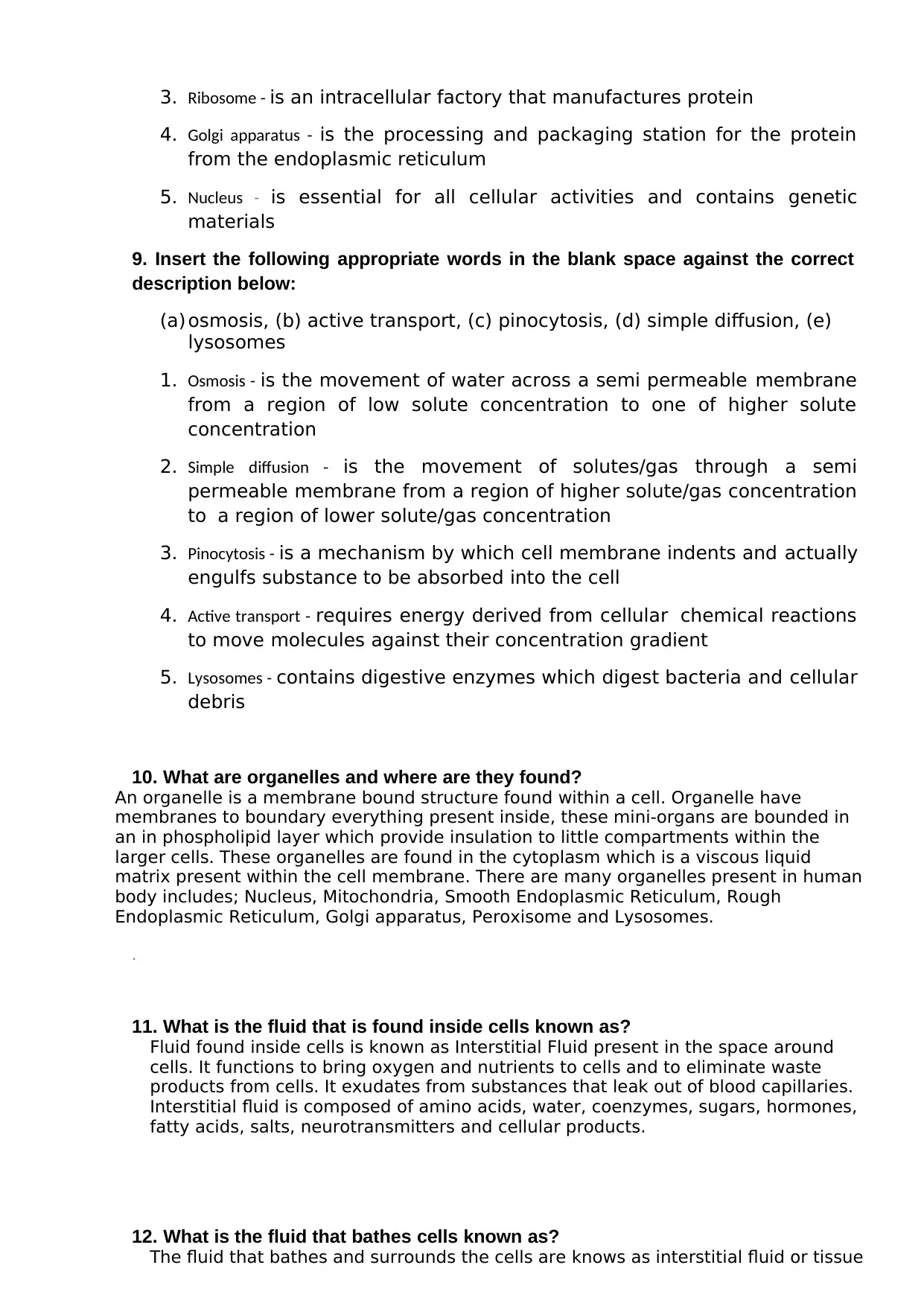
3. Ribosome - is an intracellular factory that manufactures protein
4. Golgi apparatus - is the processing and packaging station for the protein
from the endoplasmic reticulum
5. Nucleus - is essential for all cellular activities and contains genetic
materials
9. Insert the following appropriate words in the blank space against the correct
description below:
(a) osmosis, (b) active transport, (c) pinocytosis, (d) simple diffusion, (e)
lysosomes
1. Osmosis - is the movement of water across a semi permeable membrane
from a region of low solute concentration to one of higher solute
concentration
2. Simple diffusion - is the movement of solutes/gas through a semi
permeable membrane from a region of higher solute/gas concentration
to a region of lower solute/gas concentration
3. Pinocytosis - is a mechanism by which cell membrane indents and actually
engulfs substance to be absorbed into the cell
4. Active transport - requires energy derived from cellular chemical reactions
to move molecules against their concentration gradient
5. Lysosomes - contains digestive enzymes which digest bacteria and cellular
debris
10. What are organelles and where are they found?
An organelle is a membrane bound structure found within a cell. Organelle have
membranes to boundary everything present inside, these mini-organs are bounded in
an in phospholipid layer which provide insulation to little compartments within the
larger cells. These organelles are found in the cytoplasm which is a viscous liquid
matrix present within the cell membrane. There are many organelles present in human
body includes; Nucleus, Mitochondria, Smooth Endoplasmic Reticulum, Rough
Endoplasmic Reticulum, Golgi apparatus, Peroxisome and Lysosomes.
.
11. What is the fluid that is found inside cells known as?
Fluid found inside cells is known as Interstitial Fluid present in the space around
cells. It functions to bring oxygen and nutrients to cells and to eliminate waste
products from cells. It exudates from substances that leak out of blood capillaries.
Interstitial fluid is composed of amino acids, water, coenzymes, sugars, hormones,
fatty acids, salts, neurotransmitters and cellular products.
12. What is the fluid that bathes cells known as?
The fluid that bathes and surrounds the cells are knows as interstitial fluid or tissue
4. Golgi apparatus - is the processing and packaging station for the protein
from the endoplasmic reticulum
5. Nucleus - is essential for all cellular activities and contains genetic
materials
9. Insert the following appropriate words in the blank space against the correct
description below:
(a) osmosis, (b) active transport, (c) pinocytosis, (d) simple diffusion, (e)
lysosomes
1. Osmosis - is the movement of water across a semi permeable membrane
from a region of low solute concentration to one of higher solute
concentration
2. Simple diffusion - is the movement of solutes/gas through a semi
permeable membrane from a region of higher solute/gas concentration
to a region of lower solute/gas concentration
3. Pinocytosis - is a mechanism by which cell membrane indents and actually
engulfs substance to be absorbed into the cell
4. Active transport - requires energy derived from cellular chemical reactions
to move molecules against their concentration gradient
5. Lysosomes - contains digestive enzymes which digest bacteria and cellular
debris
10. What are organelles and where are they found?
An organelle is a membrane bound structure found within a cell. Organelle have
membranes to boundary everything present inside, these mini-organs are bounded in
an in phospholipid layer which provide insulation to little compartments within the
larger cells. These organelles are found in the cytoplasm which is a viscous liquid
matrix present within the cell membrane. There are many organelles present in human
body includes; Nucleus, Mitochondria, Smooth Endoplasmic Reticulum, Rough
Endoplasmic Reticulum, Golgi apparatus, Peroxisome and Lysosomes.
.
11. What is the fluid that is found inside cells known as?
Fluid found inside cells is known as Interstitial Fluid present in the space around
cells. It functions to bring oxygen and nutrients to cells and to eliminate waste
products from cells. It exudates from substances that leak out of blood capillaries.
Interstitial fluid is composed of amino acids, water, coenzymes, sugars, hormones,
fatty acids, salts, neurotransmitters and cellular products.
12. What is the fluid that bathes cells known as?
The fluid that bathes and surrounds the cells are knows as interstitial fluid or tissue
⊘ This is a preview!⊘
Do you want full access?
Subscribe today to unlock all pages.

Trusted by 1+ million students worldwide

fluid. The fluid is found in interstitial spaces also known as tissue spaces. The fluid
provides nutrients to the cells of the body and helps in removing waste material
from cell. Many researches revealed that an individual supposed to hold about 11
liters of interstitial fluid within their body.
.
provides nutrients to the cells of the body and helps in removing waste material
from cell. Many researches revealed that an individual supposed to hold about 11
liters of interstitial fluid within their body.
.
Paraphrase This Document
Need a fresh take? Get an instant paraphrase of this document with our AI Paraphraser
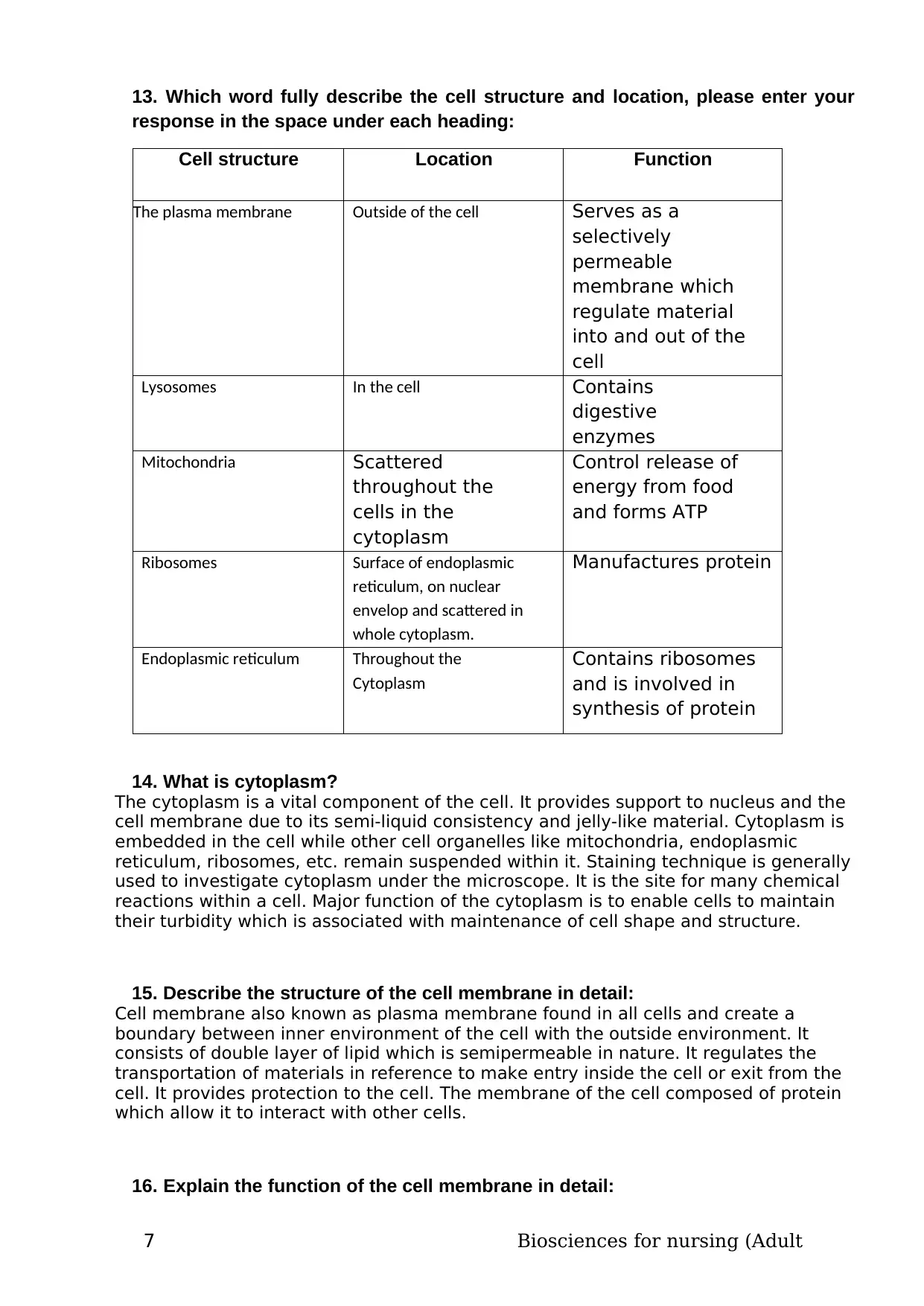
7 Biosciences for nursing (Adult
Nursing)
13. Which word fully describe the cell structure and location, please enter your
response in the space under each heading:
Cell structure Location Function
The plasma membrane Outside of the cell Serves as a
selectively
permeable
membrane which
regulate material
into and out of the
cell
Lysosomes In the cell Contains
digestive
enzymes
Mitochondria Scattered
throughout the
cells in the
cytoplasm
Control release of
energy from food
and forms ATP
Ribosomes Surface of endoplasmic
reticulum, on nuclear
envelop and scattered in
whole cytoplasm.
Manufactures protein
Endoplasmic reticulum Throughout the
Cytoplasm
Contains ribosomes
and is involved in
synthesis of protein
14. What is cytoplasm?
The cytoplasm is a vital component of the cell. It provides support to nucleus and the
cell membrane due to its semi-liquid consistency and jelly-like material. Cytoplasm is
embedded in the cell while other cell organelles like mitochondria, endoplasmic
reticulum, ribosomes, etc. remain suspended within it. Staining technique is generally
used to investigate cytoplasm under the microscope. It is the site for many chemical
reactions within a cell. Major function of the cytoplasm is to enable cells to maintain
their turbidity which is associated with maintenance of cell shape and structure.
15. Describe the structure of the cell membrane in detail:
Cell membrane also known as plasma membrane found in all cells and create a
boundary between inner environment of the cell with the outside environment. It
consists of double layer of lipid which is semipermeable in nature. It regulates the
transportation of materials in reference to make entry inside the cell or exit from the
cell. It provides protection to the cell. The membrane of the cell composed of protein
which allow it to interact with other cells.
16. Explain the function of the cell membrane in detail:
Nursing)
13. Which word fully describe the cell structure and location, please enter your
response in the space under each heading:
Cell structure Location Function
The plasma membrane Outside of the cell Serves as a
selectively
permeable
membrane which
regulate material
into and out of the
cell
Lysosomes In the cell Contains
digestive
enzymes
Mitochondria Scattered
throughout the
cells in the
cytoplasm
Control release of
energy from food
and forms ATP
Ribosomes Surface of endoplasmic
reticulum, on nuclear
envelop and scattered in
whole cytoplasm.
Manufactures protein
Endoplasmic reticulum Throughout the
Cytoplasm
Contains ribosomes
and is involved in
synthesis of protein
14. What is cytoplasm?
The cytoplasm is a vital component of the cell. It provides support to nucleus and the
cell membrane due to its semi-liquid consistency and jelly-like material. Cytoplasm is
embedded in the cell while other cell organelles like mitochondria, endoplasmic
reticulum, ribosomes, etc. remain suspended within it. Staining technique is generally
used to investigate cytoplasm under the microscope. It is the site for many chemical
reactions within a cell. Major function of the cytoplasm is to enable cells to maintain
their turbidity which is associated with maintenance of cell shape and structure.
15. Describe the structure of the cell membrane in detail:
Cell membrane also known as plasma membrane found in all cells and create a
boundary between inner environment of the cell with the outside environment. It
consists of double layer of lipid which is semipermeable in nature. It regulates the
transportation of materials in reference to make entry inside the cell or exit from the
cell. It provides protection to the cell. The membrane of the cell composed of protein
which allow it to interact with other cells.
16. Explain the function of the cell membrane in detail:
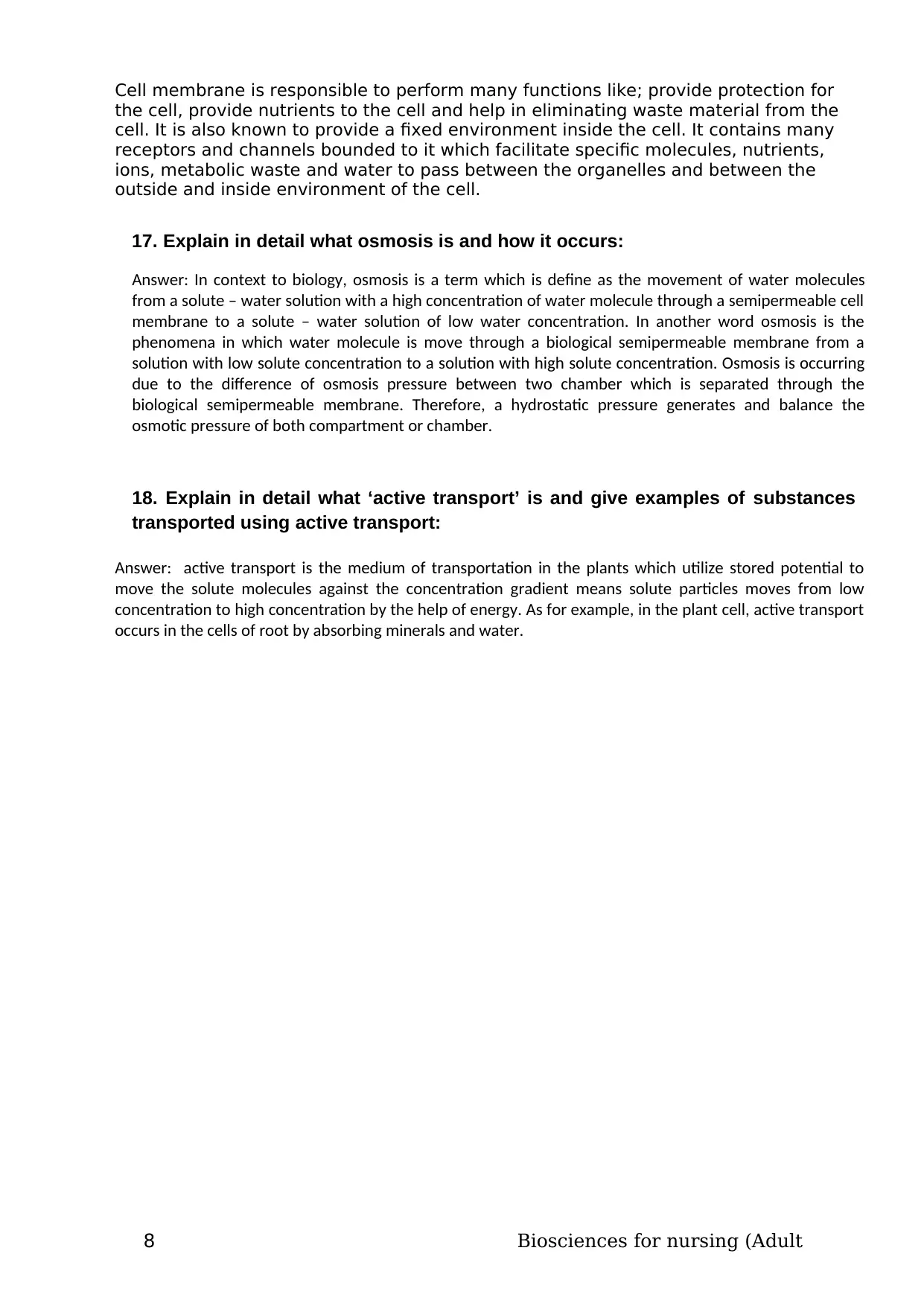
8 Biosciences for nursing (Adult
Nursing)
Cell membrane is responsible to perform many functions like; provide protection for
the cell, provide nutrients to the cell and help in eliminating waste material from the
cell. It is also known to provide a fixed environment inside the cell. It contains many
receptors and channels bounded to it which facilitate specific molecules, nutrients,
ions, metabolic waste and water to pass between the organelles and between the
outside and inside environment of the cell.
17. Explain in detail what osmosis is and how it occurs:
Answer: In context to biology, osmosis is a term which is define as the movement of water molecules
from a solute – water solution with a high concentration of water molecule through a semipermeable cell
membrane to a solute – water solution of low water concentration. In another word osmosis is the
phenomena in which water molecule is move through a biological semipermeable membrane from a
solution with low solute concentration to a solution with high solute concentration. Osmosis is occurring
due to the difference of osmosis pressure between two chamber which is separated through the
biological semipermeable membrane. Therefore, a hydrostatic pressure generates and balance the
osmotic pressure of both compartment or chamber.
18. Explain in detail what ‘active transport’ is and give examples of substances
transported using active transport:
Answer: active transport is the medium of transportation in the plants which utilize stored potential to
move the solute molecules against the concentration gradient means solute particles moves from low
concentration to high concentration by the help of energy. As for example, in the plant cell, active transport
occurs in the cells of root by absorbing minerals and water.
Nursing)
Cell membrane is responsible to perform many functions like; provide protection for
the cell, provide nutrients to the cell and help in eliminating waste material from the
cell. It is also known to provide a fixed environment inside the cell. It contains many
receptors and channels bounded to it which facilitate specific molecules, nutrients,
ions, metabolic waste and water to pass between the organelles and between the
outside and inside environment of the cell.
17. Explain in detail what osmosis is and how it occurs:
Answer: In context to biology, osmosis is a term which is define as the movement of water molecules
from a solute – water solution with a high concentration of water molecule through a semipermeable cell
membrane to a solute – water solution of low water concentration. In another word osmosis is the
phenomena in which water molecule is move through a biological semipermeable membrane from a
solution with low solute concentration to a solution with high solute concentration. Osmosis is occurring
due to the difference of osmosis pressure between two chamber which is separated through the
biological semipermeable membrane. Therefore, a hydrostatic pressure generates and balance the
osmotic pressure of both compartment or chamber.
18. Explain in detail what ‘active transport’ is and give examples of substances
transported using active transport:
Answer: active transport is the medium of transportation in the plants which utilize stored potential to
move the solute molecules against the concentration gradient means solute particles moves from low
concentration to high concentration by the help of energy. As for example, in the plant cell, active transport
occurs in the cells of root by absorbing minerals and water.
⊘ This is a preview!⊘
Do you want full access?
Subscribe today to unlock all pages.

Trusted by 1+ million students worldwide
1 out of 19
Related Documents
Your All-in-One AI-Powered Toolkit for Academic Success.
+13062052269
info@desklib.com
Available 24*7 on WhatsApp / Email
![[object Object]](/_next/static/media/star-bottom.7253800d.svg)
Unlock your academic potential
Copyright © 2020–2025 A2Z Services. All Rights Reserved. Developed and managed by ZUCOL.




